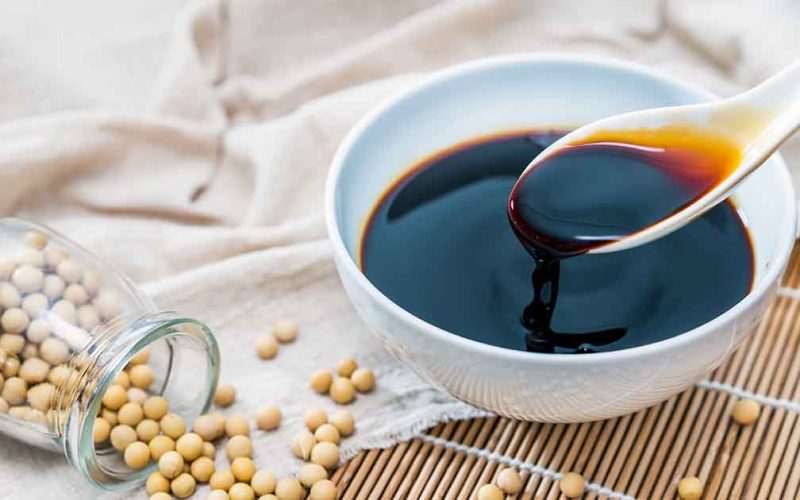Your favorite Asian dishes are not the same without Tamari, but since you’re avoiding gluten in your diet. You might have cut it out of your life completely.
However, you can use several delicious substitutes for Tamari in its place. Here are the best substitutes for Tamari and how to use them in your everyday cooking routine.
Let’s read through it together.
1. Soy Sauce
First on our list of substitutes for Tamari is soy sauce. The all-purpose soy sauce makes one of the best substitutes for Tamari.
It has a lighter flavor than Tamari and is commonly used as dish seasoning. It is not an added flavoring agent.
Furthermore, if you use soy sauce as a substitute for Tamari, you should use twice as much when measuring.
For example, one tablespoon of soy sauce can be substituted with two tablespoons of Tamari. Soy sauce also has less sodium than Tamari.
In addition, depending on its variety, soy sauce can have added flavors (such as garlic or sesame). When using soy sauce in your recipes, it is best to start with lower amounts.
Then, adjust if needed. You don’t want your dish to taste too salty!
2. Coconut Aminos
Coconut aminos are another one on our list of substitutes for Tamari. If you want to reduce your sodium intake, coconut aminos could be just what you need.
It is made from sap produced by coconut trees. It tastes similar to soy sauce but is much lower in sodium. It has 80 milligrams of sodium per serving compared to 360 milligrams in soy sauce.
You can use it as a meat tenderizer and flavor enhancer or add it to stir-fries and marinades. Furthermore, It also contains 17 amino acids that promote muscle growth and repair.
Due to its high carbohydrate content, coconut aminos are not recommended if you have gluten intolerance or celiac disease. However, many people without these conditions can eat coconut aminos without adverse effects.
3. Oyster Sauce
Think of oyster sauce as a sweet and savory liquid full of umami. The fifth flavor (savoriness) is often lacking in vegan food. It’s generally made with oyster extract, salt, sugar, cornstarch, and water.
The resulting rich concoction can add an extra layer of umami-rich flavor to stir-fries. You can even use it for vegetables such as broccoli. Most commercial brands are not vegetarian or vegan because they contain fish extracts.
Fortunately, several commercially available options, including Lee Kum Kee’s vegetarian oyster sauce and Annie Chun’s organic vegan version, are available. Other substitutes for Tamari include coconut aminos or soy sauce.
4. Molasses
Molasses can add an umami note to dishes ranging from chicken wings to vegan chili. If you love bold flavors but don’t want to eat animal products, you can try molasses.
Molasses can substitute for soy sauce in your marinades and sauces. It brings sweet, salty, earthy, and rich flavors to dishes in place of salt.
Also, try substituting Dijon mustard for Worcestershire sauce in stir-fries or French onion soup. You can try wine vinegar for soy sauce on steamed vegetables.
Also, balsamic vinegar with olive oil drizzled over roasted vegetables is good. Finally, These are excellent substitutes for Tamari to put together for you! It would help if you tried them for a better and stress-free cooking experience.
5. Liquid Aminos
One of the simplest and best substitutes for Tamari is liquid aminos. Typically, Tamari is a more decadent, darker soy sauce specifically made to be wheat-free.
Liquid aminos are usually lighter in color. However, they’re much saltier and don’t have that distinct soy flavor you’ll find in Tamari.
It is a great substitute when you need a flavorful seasoning but don’t want a rich taste. You can also use it as part of marinades or as a general condiment on vegetable sides.
6. Fish Sauce
Fish sauce is an anchovy-based condiment. It’s salty, tangy, and packs a big umami punch. It also has a strong flavor, smells fishy, and substitutes for Tamari well!
Also, some things are not precisely appealing, such as a salad topping or dip for crackers. Fortunately, there are substitutes for a fish sauce that can mimic its saltiness and savory taste in recipes.
Don’t worry. It doesn’t give up on its signature fishy smell or overpower other flavors with its pungency.
7. Vegetable Broth Powder
Vegetable broth powder is a delicious alternative to soy sauce. This seasoning is packed with umami flavor and is also naturally gluten-free.
You can find vegetable broth powder in most grocery stores or make your own. Furthermore, combine one teaspoon of dried parsley, 1⁄4 teaspoon of dried thyme, and two teaspoons of onion powder.
Grind them until they resemble fine sand using a spice grinder or food processor. Grind them until they resemble fine sand. Combine two tablespoons with 1 cup water to substitute for 1⁄2 cup soy sauce in any recipe.
Finally, vegetable broth powder is an amazing substitute for Tamarind. All you need to do is get the recipe right!
8. Worcestershire Sauce
They are made from fermented anchovies, vinegar, and spices. Worcestershire sauce packs a spicy, savory punch. It can be used as a marinade or added to Asian recipes.
Soy Sauce is more popular than Worcestershire sauce in most Asian countries (and many other non-Asian cuisines).
Also, soy sauce is made from brewed soybeans, wheat, and salt and is considered by many chefs to be an essential ingredient in most pantries.
Fish Sauce is a staple ingredient in Thai cooking, adding saltiness and savory umami flavor to food. Oyster Sauce is also traditionally used in Chinese cuisine.
Oyster sauce gives dishes a delicate sweet/salty taste and enriches fried rice or egg rolls. It’s one of Tamari’s substitutes, and it never disappoints.
9. Mirin
This is a sweet, low-alcohol wine made from glutinous rice. It gives Asian dishes a glistening sheen without a lot of added sugar.
To use as a substitute for Tamarind in Asian cooking, swap out one tablespoon of mirin for each teaspoon of Tamarind called for in your recipe.
Mirin is very strong, so use it sparingly when seasoning soups and stews. To balance its sweetness, you’ll also want to add extra soy sauce or fish sauce.
Finally, if too much mirin has been added to a dish made with Tamarind, Cover and Refrigerate Overnight. The flavor will mellow dramatically. Mirin is one of Tamarind’s best substitutes, which is always handy.
10. Monosodium Glutamate
Glutamate has long been used as a food additive in Asian cuisine, but its origins are chemical. It’s produced from starch through fermentation and hydrolysis.
This is done by breaking down a large protein molecule into smaller amino acids. Furthermore, MSG is most commonly found in Chinese or Asian restaurants that cater to American tastes.
MSG may be labeled on food packages as spices or hydrolyzed vegetable protein (HVP) in the US. This kind of vegetable contains MSG and salt.
Also, most processed foods contain glutamate, which enhances flavor and makes foods seem savory. Are these suggested substitutes for Tamari helping out? Let us know!
11. Anchovies
If you’re a Tamari and fish sauce fan, you’ll be happy to know that many brands contain anchovies. Swap in your favorite flavor of anchovy-based fish sauce.
It gives dishes a saltier taste but does not overpower other seasonings. Additionally, to ensure you’re buying a quality product, it’s best to stick with major brands like Red Boat or Three Crabs.
Buy in small bottles so your supply won’t spoil before you use it all. I recommend anchovies as one of the substitutes for Tamari you might need.
12. Miso
Miso paste is an excellent addition to broths and marinades. It can also be used as a flavorful replacement for soy sauce. It has an especially strong taste, so use it sparingly.
However, different types of miso pastes do have varying levels of saltiness. They’re all made from fermented soybeans and are high in protein and vitamins B1, B2, B3, and B12.
Each brand will vary in salt content, but it’s still one of the best substitutes for Tamari. If you’re watching your sodium intake, check your labels to see which miso paste is best.
One tablespoon of most miso pastes provides about 1 gram of protein and over 100 milligrams of sodium.
13. Hoisin Sauce
One perfect substitute for Tamari is hoisin sauce. It’s made from soybeans, garlic, and chiles. You can use it in stir-fries or marinades and as a dipping sauce with dumplings and spring rolls.
Also, a few tablespoons of hoisin sauce can replace about two tablespoons of Tamari, which is 1/4 cup. Beware, hoisin is much sweeter than Tamari.
Therefore, if you decide to use it as a direct substitute, you’ll want to use a little less. If you’re unsure how much to use, try adding it in increments of 1 tablespoon. You can do this until you get it right.
14. Umeboshi Vinegar
Umeboshi vinegar is a vegan substitute for Tamari. Its tart, salty taste is derived from ume plums.
Mix it with olive oil to use it as a salad dressing or marinade. You can also sprinkle it on over-baked fish or tofu before roasting in your oven.
You can buy a bottle of umeboshi vinegar at most natural grocery stores and Asian food markets, or you can make your own. See our Umeboshi Vinegar recipe.
15. Balsamic Vinegar
To take advantage of balsamic vinegar’s sweet, tangy flavor without soy sauce, use a 2-to-1 ratio of balsamic to Tamari and add your choice of herbs.
You can also buy garlic-infused varieties that are delicious on tofu or mixed with olive oil. They can also be drizzled over steamed vegetables. It’s one of the best substitutes for Tamari!
However, if you’re looking for extra umami, you might want to try caramelized balsamic. Balsamic vinegar is cooked until it develops a deep, rich flavor or truffle balsamic (gourmet vinegar). These kinds of vinegar start around $20 a bottle but are worth their price!








